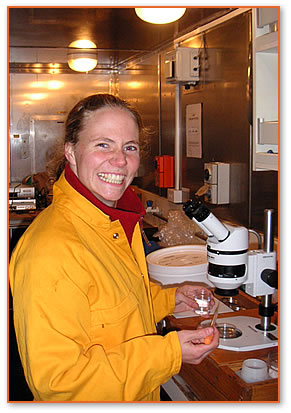Margaret Lindsay 
What interested you in science as a child?
My interest in science was derived from my imagination being captivated by microscopy images of insects and the never ending amount of detail with each magnification. This captivation, reinforced my natural curiosity and enjoyment from the fact that questions lead not to answers, but rather to more questions. Being intrigued by nature was reinforced by meeting scientist that demonstrated and shared a real passion for their research and they informed me of a career that offered the chance to travel and have adventures in isolated, extreme and exquisite locations of our planet while making a difference.
What did you study at university?
At La Trobe University in Wodonga, Victoria I completed a Bachelor of Science in Environmental Management and Ecology (Hons). My honours project was on the diet of the Pacific Gull and involved four months field work in the Furneaux Group – a magical group of islands that includes Flinders Island. The time spent there made it easy to decide to move to Tasmania a year later.
After completing honours I worked as an education officer at Wonga Wetlands Education Centre before heading to Christchurch, New Zealand to complete a Graduate Certificate in Antarctic Studies at the University of Canterbury. This involved spending time camping on the ice shelf under Mt Erebus – an active volcano on Ross Island in Antarctica.
What is your current research?
Currently I am a PhD student at the Institute of Antarctic and Southern Ocean Studies at the University of Tasmania in conjunction with the Australian Government Antarctic Division and Antarctic and Climate Ecosystem CRC studying the role of appendicularians in Southern Ocean carbon flow and trophodynamics – or the interaction between the biological, physical, chemical and geological surroundings.
That is, proving that appendicularians rule the Southern Ocean! Appendicularians are gelatinous tadpole like zooplankton found in all oceans that have a wide distribution and are in abundances that make them an important animal in the food web. Especially when considering their feeding methods contribute to carbon flow and trophodynamics.
My research involves spending months on the RSV Aurora Australis deploying nets into the Southern Ocean amongst icebergs and looking down microscopes to identify and quantify the appendicularians and other zooplankton before returning to the Australian Antarctic Division laboratories to complete identification and proceed with data analysis and writing up results.
What are your future aspirations?
My future aspirations are to travel to the North Pole and visit the South Pole and every where between while being employed as a research scientist and work with a wide range of people on a wide range of research projects in a wide range of environments. The opportunities are endless.
What do you love about science?
I love the way science is intriguing, dynamic, exciting and plunges you into unknown and unexplored territories. I agree with Isac Asimov that ‘the most exciting phrase to hear in science, the one that heralds new discoveries is not Eureka! (I found it!) but rather, “hmmm..that’s funny…”’ and I love being part of the adventure of researching these discoveries.




